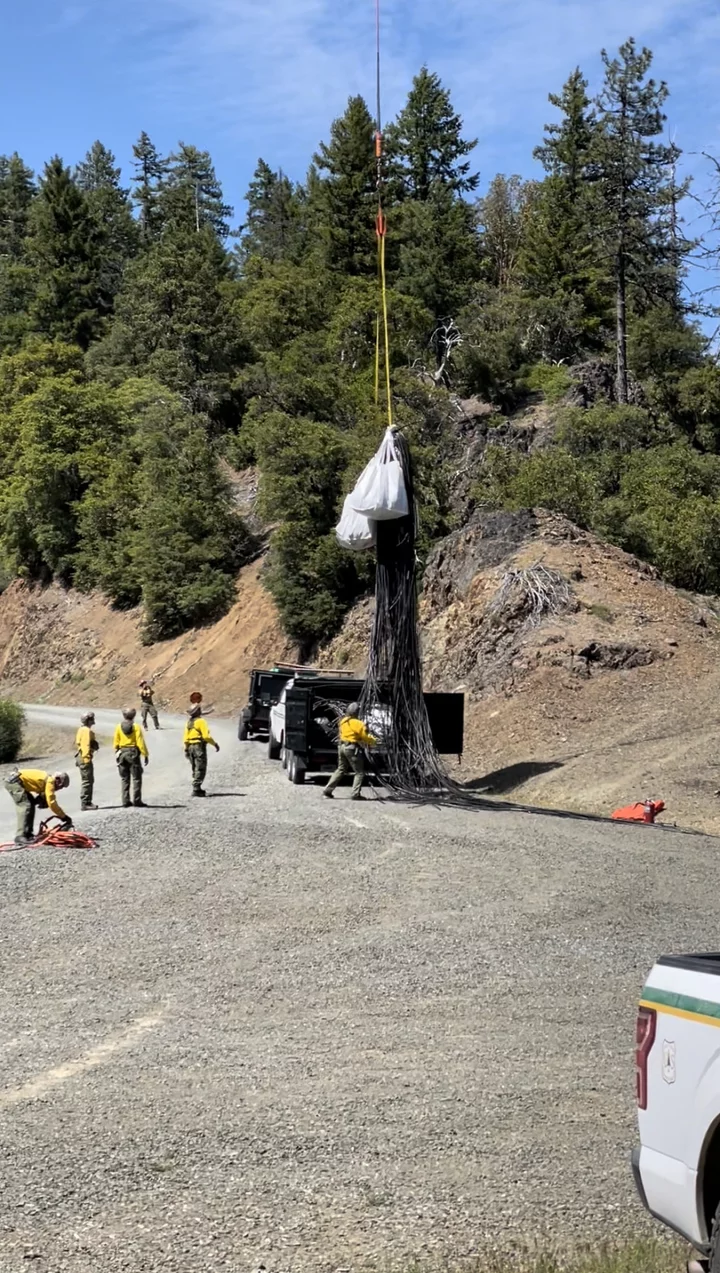Press release from Six Rivers National Forest:
Forest Service Law Enforcement Officers and Forest Service partners at the Integral Ecology Research Center recently conducted reclamation operations on several illegal marijuana grow sites within the Six Rivers National Forest. They removed 5,580 pounds of trash in four days from sites that spanned across the Lower Trinity, Orleans, Ukonom, and Mad River Ranger Districts.
Illegal marijuana grow sites on National Forest land pose problems for the public and the environment – with pesticides poisoning wildlife, soil, and water.
Researchers frequently find dead squirrels, bears, deer, and birds, and other animals killed by the pesticides used on these grow sites. Once an animal consumes and dies from pesticides, the chemicals continue powering through the entire food web as scavengers feed upon poisoned carcasses. For example, researchers have found a dead fox, a dead vulture that had been feeding on the fox, and dead insects that had landed on both.
Pesticide use is also impacting the Northern Spotted Owl, a federally threatened species and the fisher, a small mammal related to the weasel and a federal species of concern, which serves as an indicator species as the species thrives in healthy forests.
Growers’ spray pesticides and add them to irrigation systems, the chemicals then seep into the soil and surrounding waterways, which can negatively impact aquatic species and potentially compromise the safety of people’s drinking water downstream.
One marijuana plant requires approximately 9 gallons of water per day. This equals about 1,350 gallons of water per plant during the growing season. One of the reclaimed sites on the Lower Trinity Ranger District had approximately 5,000 plants. This translates to about 6.75 million gallons of water used for this one site alone.
Where are they getting the water? The irrigation systems use nearby water sources such as springs, often near headwaters. During these recent reclamation operations over 11 miles of irrigation hose was found throughout the sites. This amount of water diversion can dewater an entire spring which decreases the amount of water reaching streams and rivers below, impacting entire ecosystems. Impacts include lower salmon runs and decreased habitat for sensitive amphibians like the foothill yellow-legged frog.
To reduce the grow site impacts and discourage illegal growers from returning, Forest Service and partner law enforcement agents, scientists, safety experts, and others plan and carry out clean-up efforts to remove the plants, irrigation infrastructure, waste, and chemicals. If they leave these resources intact, growers will return and reuse the same site.
Many grow sites are in remote locations and difficult to access, making remediation efforts challenging and costly. Helicopters must be used to air-lift tons of garbage and miles of irrigation piping. Partial HAZMAT protocols must be followed, and decontamination kits used to contain and clean up the waste.
Many sites harbor booby traps, and the growers themselves are often armed. Law enforcement agents are trained to safely navigate most of these hazards, but if members of the recreating public encounter a grow site, the situation can quickly turn unsafe.
If you encounter what you believe may be an active grow site here are some suggestions on what to do and what not to do:
DO:
- Leave the area in the same way you came in, retracing your steps.
- Make observations of what you see.
- Once clear of the site, report your findings to the Forest Service or local law enforcement officials and relay your location and observations.
DON’T:
- Linger at the site.
- Call attention to yourself.
- Touch anything that looks out of the ordinary.



Photos: Six Rivers National Forest.
CLICK TO MANAGE